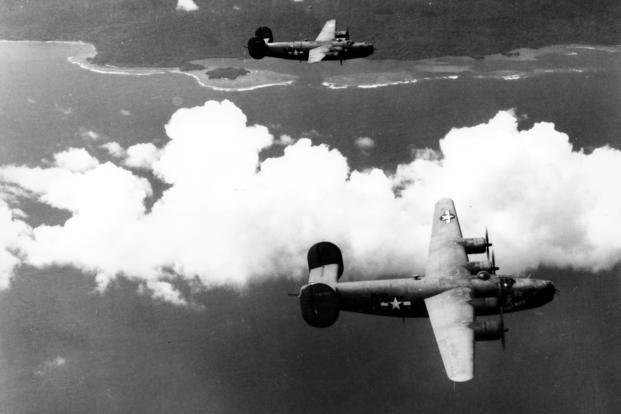(In the coming months, Military.com will profile companies that have provided significant support to the U.S. military in times of national crisis. This is Part II of a three-part series profiling General Motors' contribution to America's warfighting capabilities during World War II. This story was adapted from "The Complete History of General Motors 1908-1986" by Richard M. Langworth and Jan E. Norbye.)
As American industry rushed to create what President Franklin D. Roosevelt called "the arsenal of democracy," General Motors rose to the occasion in a big way. And in the process of morphing from automobile manufacturer to war supplier, the company made sacrifices that underwrote the successes American forces would have on battlefields in both theaters in the challenging years that followed.
Read Part 1: How an Auto Giant Got Ready for War
In February 1942, Fisher Body completely stopped making auto bodies and began assembling the famous M-4 "Sherman" tank in its No. 1 plant in Flint, Michigan. The operation eventually moved to Grand Blanc and turned out 11,358 tanks by 1945.
Buick tackled the manufacturing of ammunition, churning out 75,000 casings per month for the duration. By the war's end, the division had supplied more than 12.5 million casings.
Buick also retooled to meet the demands of making engines for the B-24 bomber. At first, they talked of about 500 engines a month, but the government doubled its order by the time Buick had its tooling in place. By 1944, Buick's Melrose Park, Ill., factory was regularly turning out 2,000 engines a month.
To produce the cylinder heads, Buick set up its own aluminum foundry, which it then leased to the government. The initial production target was 25,000 a month, but that was tripled before construction began and the foundry had to be scaled up nine or 10 times. The goal was later set at 125,000 heads a month, and Buick met it.
The Army also asked Buick to design a new kind of war machine: the tank destroyer. The specs called for a lightly armored, highly mobile tracked vehicle fitted with a 37mm cannon in a 360-degree turret. The Army initially wanted diesel power but settled on gasoline engines to speed up delivery. Buick even devised an automatic transmission for it -- a hydraulic torque converter.
The vehicle was officially known as the M18, but Buick workers dubbed it the "Hellcat." The division eventually built 2,507 M18s. The transmission was later made four times bigger to accommodate the requirements for the Pershing tank.
GM's Cadillac division took to making tanks, specifically the M5. The design was obsolete, but at the beginning of America's involvement in World War II, the Army wanted all of them it could get.
Down in Indianapolis, the V-1710 aircraft engine designed by GM's Allison division was a long way from being production ready, and Allison was hopelessly short of production capacity. Yet it was a vital power unit, destined for both the twin-boom Lockheed P-38 "Lightning" and North American Aviation's P-51 "Mustang" fighters.
In time, GM's auto engineers developed the turbocharged V-12 that was probably the most advanced aircraft engine to see action during World War II. Cadillac's Clark Avenue home plant in Detroit speeded its production by turning out the required crankshafts, connecting rods, camshafts and reduction-gear assemblies.
Chevrolet plants produced shells, gun parts and aircraft engines. The division made around 3,000 armored cars and built a light-armor half-track that saw action in Gen. George Patton's North African campaign. Part of Chevy's Tarrytown plant in New York built 1.5-ton trucks and ambulances for the U.S. Army, while another part produced wing section and fuselage components as a subcontractor to Grumman Aircraft.
Oldsmobile manufactured 48 million rounds of artillery ammunition, 140,000 aircraft machine guns, 350,000 high-precision aircraft engine parts and 175 million pounds of forgings for military trucks, tanks, guns and aircraft.
Pontiac, as one ad at the time put it, "was at war nine months before Pearl Harbor," first making an anti-aircraft gun for the U.S. Navy and then clearing 200,000 square feet in its sheet metal plant to install the precision equipment needed to make the Swedish-designed Bofors automatic field guns for the U.S. Army.
Pontiac also supplied front axles for the M-5 tanks built by Cadillac and air-launched torpedoes for the U.S. Navy. The torpedoes were a challenge in that each one had 5,222 parts and 1,225 assemblies that had to fit inside a slim envelope about 20 feet long.
In all, more than 113,000 employees left GM to serve while the company churned out $12.3 billion in aircraft, tanks, vehicles and arms.
When it was all counted up after the war, GM had produced 854,000 trucks (including the legendary DUKW, or "Duck" amphibious vehicles), 198,000 diesel engines, 206,000 aircraft engines and 38,000 tanks, tank destroyers, and armored vehicles, not to mention vast quantities of guns and ammunition.
For more on GM and its contributions to the U.S. military throughout history, visit the GM Military History page.
Find the Right Veteran Job
Whether you want to polish your resume, find veteran job fairs in your area or connect with employers looking to hire veterans, Military.com can help. Subscribe to Military.com to have job postings, guides and advice, and more delivered directly to your inbox.











